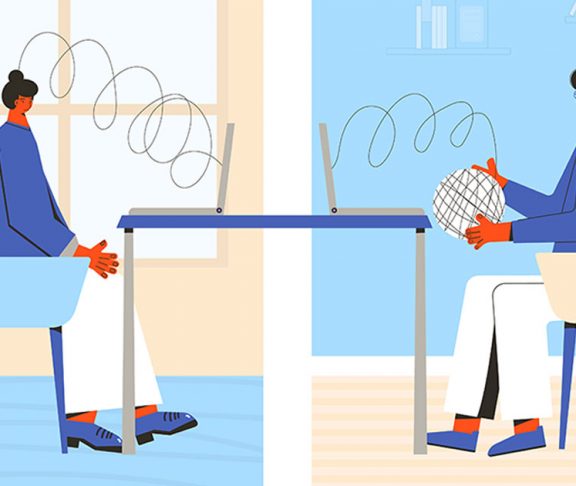Colleges and universities are at a pivotal moment as new students begin classes in online and socially distanced classrooms. Joyce Hall, executive director of NODA-Association for Orientation, Transition and Retention in Higher Education, talks about how institutions can still provide a balanced and social college experience during the COVID-19 crisis.

Joyce Hall
Executive Director, NODA-Association for Orientation, Transition and Retention in Higher Education
How can universities and colleges still provide the “essence” and “energy” of campus life during this virtual period?
Don’t just talk about it — SHOW it. Show them the campus, show them residence halls, show them students being students — walking across campus, in classrooms, in dining. Help them see energy, not just people in video boxes. Quit using “new Normal” — none of this is normal for them, anyway. Talk with the future in your language “WHEN we are together,” “we can’t wait,” but have an “in the meantime” plan.
While this may be different than what students expected from their first semester, as campuses, we are still thrilled to have these new students join our communities! Any way to share this energy through in-class experiences, digital and social media, and student events can convey this to students, and hopefully help them get a sense for what they can expect from campus life, whether in-person or remote.
Creating opportunities for students to connect with faculty and staff is important, regardless of modality. Phone calls, emails, virtual gatherings, etc. are ways to create some human connection. We must show some willingness to engage in meaningful practices that support campus life while being safe.
How can universities and colleges help freshmen feel welcome during this time?
We are all exhausted and worried — they should not sense that at all. They deserve our attention, our time, our energy. They need it more than other classes have.
deserve our attention, our time, our energy. They need it more than other classes have.
Within guidelines, have the events. Make it easy for them to join. Put current students in front of them whenever possible.
Create opportunities for students to create social connections through a peer mentoring program or affinity-based groups (e.g., regional affiliation, social identities, hobbies and interests). In a virtual environment, it can feel less personal, so any efforts to create more personal experiences to connect students directly with each other will help them feel more connected to the campus community.
Students are craving a human connection and their experiences of college will be defined by how they connected with each other, and with faculty and staff. The opportunity to engage in in-person interactions while practicing mask wearing, physical distancing, handwashing, etc. will create some affinity to the institution.
Faculty, staff, and students are still trying to wrap their minds around how to do this as safely as possible.
If you could give one piece of advice to a dean or school administrator on how to improve student success, what would it be?
Communicate more than you think is necessary. If we’ve learned anything, it is that this is a confusing time made more so by the ever-changing playing field. Now is not the time to appear at all non-communicative or unavailable.
Create opportunities for students to engage more directly with faculty around their academics outside of a formal class setting. With many courses being delivered asynchronously or in a hybrid format, students may feel less focused or clear on how to be successful, as well as feel more disconnected from their faculty without an in-person class experience on a regular basis.
Seek input from the student body. This includes formal and informal mechanisms for feedback about student success. We must be intentional about the types of efforts we are employing and be informed by campus data. Quantitative data speaks volumes but is not the only way to measure student success and outcomes.
What particular advice do you have to universities and colleges welcoming transfer students during this virtual period?
Like when we are in person, be sure to honor their experience, but do not assume they know everything they need to know. They come to us with assumptions about how college “really is” but there is a reason they are transferring to us.
Identify specific ways for transfer students to connect with one another so they can relate to those with similar experiences. In addition, there are several institutions that have created mentoring programs that connect transfer students with faculty members, which can be a powerful way to welcome these students who have experience with college life, but may be seeking greater connection to their academic pursuits or adult mentors.
Recognize the unique needs of transfer students and the fact they are not a monolithic group. Tailoring programming to the various types of subsets of transfer students is important.
There might be a slight advantage for transfer students as they know the college environment prior to COVID. Helping them get acclimated to the virtual environment will be important, but also opportunities to engage one-on-one with peers, faculty, and staff will help students feel like they belong at the institution.
How can universities and colleges use the current climate to reevaluate their student success strategies?
Take what we are learning about accessibility and who is getting left out of the conversation by virtue of accessibility.
In this current climate, we need to do more work collaboratively across functional areas to create experiences or support services that meet the needs of students holistically. Students will be more successful if we bring together academics and student life, for example, to think big picture about student needs in the current climate, and identify interdisciplinary and dynamic ways to address these needs, rather than creating duplicative programming or services in silos.
Accept this as a culture-changing event and embrace the change. Don’t cling to past practices and start defining how services and programs will look in the future. Blending online and in-person experiences will be necessary moving forward.
Everyone right now is open to making changes because our current context necessitates it. It is important to leverage this moment not just for the immediate needs but also for the long term. The reality is that COVID is going to be with us for at least another year, and we have to think about the needs of students as they come to us, and adjust our programs and services to meet their needs.
What do you believe is one innovation that will impact higher ed over the next few years?
We will make better use of online options — balancing them with in-person orientation and experiences so as not to REPLACE the valuable in-person time, but to enhance it and provide a space for multiple learning styles.
Integrating telecommuting will change higher education and provide much-need flexibility to staff.

